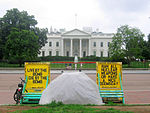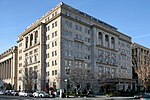Lafayette Square Historic District, Washington, D.C.
Federal architecture in Washington, D.C.Gilbert du Motier, Marquis de LafayetteHistoric American Buildings Survey in Washington, D.C.Historic districts on the National Register of Historic Places in Washington, D.C.NRHP infobox with nocat ... and 3 more
National Historic Landmarks in Washington, D.C.Northwest (Washington, D.C.)Victorian architecture in Washington, D.C.

The Lafayette Square Historic District is a National Historic Landmark District in Washington, D.C., encompassing a portion of the original L'Enfant Plan for the city's core. It includes the 7-acre (2.8 ha) Lafayette Square portion of President's Park, all of the buildings facing it except the White House, and the buildings flanking the White House to the east and west. The district was designated a National Historic Landmark in 1970.
Excerpt from the Wikipedia article Lafayette Square Historic District, Washington, D.C. (License: CC BY-SA 3.0, Authors, Images).Lafayette Square Historic District, Washington, D.C.
Pennsylvania Avenue Northwest, Washington
Geographical coordinates (GPS) Address Nearby Places Show on map
Geographical coordinates (GPS)
| Latitude | Longitude |
|---|---|
| N 38.899694444444 ° | E -77.036527777778 ° |
Address
Andrew Jackson
Pennsylvania Avenue Northwest
20006 Washington
District of Columbia, United States
Open on Google Maps








